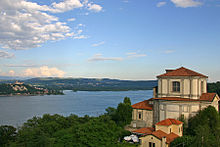Sacro Monte di Arona
The Sacro Monte di Arona with its view of Lake Maggiore is dedicated to St. Dedicated to Charles Borromeo . It can be seen as part of the system of the pre-alpine Sacri Monti , which, especially in the 16th and 17th centuries, marked the rise of popular religiosity that was expressed in Piedmont and Lombardy .
The story and the artistic environment
The construction of the Sacro Monte on a hill behind the city of Arona , where the saint was born in 1538, was promoted by the Oblate Father Marco Aurelio Grattarola after his beatification (1610) .
The project conceived by Father Grattarola was supposed to celebrate the figure of the Archbishop of Milan - especially in the home of the Borromeo family and against the backdrop of Lake Maggiore . This gave rise to the idea of a colossal statue on the summit of Monte, which could also be seen from the other side of the lake. The initiative received the applause and support of Federico Borromeo , who in the meantime had succeeded the saint - of which he was a cousin - as head of the Archdiocese of Milan .
The architect Francesco Maria Richini - a representative of the Lombard Baroque - proposed an ambitious solution, which - as with most of the Sacri Monti - was only partially implemented.
From a triumphal arch at the foot of the hill as the entrance to the prayer path, three paths were to lead up the slopes of the mountain; On each path, five chapels with their statues and frescoes should show the most important works of St. Tell Carlo (the “vita attiva”) in his pastoral office; further above, other chapels should illustrate the examples of spirituality (the "vita contemplativa") that he provided.
In July 1614, Federico Borromeo celebrated the start of construction in the presence of a large number of believers. Not far away they were in the process of building the Sacri Monti of Orta and Varese .
One of the main tasks of the work was the construction of the pilgrimage site (or Church of San Carlo) on the top of the mountain based on a project by Richini , who designed a central building with numerous classic reminiscences .
Few of the proposed project by Richinis chapels were built: remain today just three of them with their elegant classical style, but do not have a decorative apparatus more of which nothing is known. However, as confirmation of the initially ambitious project, it is known that Melchiorre d'Enrico, brother and collaborator of Giovanni d'Enrico, the protagonist of the work on the Sacro Monte di Varallo , was consulted to realize the statues .
Indeed, difficulties soon arose in carrying out the project, on the one hand the untimely death of Father Grattarola (1615), then the social and economic problems caused by the " Manzonian plague " of 1629–31, and finally the death of Cardinal Borromeo (1631) .
The Sacro Monte project - the management of which had passed to the curators of the Biblioteca Ambrosiana - had to struggle with difficulties for years and the chapels that had already been built began to deteriorate.
A more confident resumption of the execution program took place from 1692, again through the will of the Borromeo family, who hired the papal architect Carlo Fontana for the new work . The new building program compromised the ideas that Grattarolo and Federico Borromeo had in mind: in fact, the idea of the Sacro Monte itself with a large number of chapels in honor of the saint was abandoned.
The pilgrimage church was not completed until 1725 with the construction of the roof. Today you can see a painting by Giulio Cesare Procaccini above the main altar. Behind the altar is the original room of St. Carlo reconstructed with furnishings that were saved when Napoleon Bonaparte destroyed the nearby Rocca Borromea Castle .
Opposite the church on the other side of the square is the “Seminary of St. Carlo ”, which was completed in 1640 and expanded significantly at the beginning of the 20th century.
From the square there is a staircase that leads to the high granite base on which the colossal copper statue of St. Carlo rises, which was conceived from the beginning as the coronation and strong identity feature of the Sacro Monte. The statue was designed by Giovanni Battista Crespi called Cerano, an artist who was particularly fond of Federico Borromeo and who was commissioned with the work for a certain time.
The 28-meter-high work (which popular veneration soon gave the name of San Carlone - Saint Carlo the Great) was made by the sculptors Siro Zanella from Pavia and Bernardo Falconi from Lugano , not without technical difficulties : it was completed in 1698. It is about a hollow statue composed of machined copper plates. Visitors can climb up to the head of the colossus via an internal staircase. Among the metal statues, it is only surpassed in height by the Statue of Liberty in New York .
The Colossus of St. Carlo (who should have been erected as his coronation in the perspective of the last chapels on the way to Sacro Monte) is considered an attraction.
literature
- Massimo Centini: I Sacri Monti nell'arco alpino italiano. Priuli & Verlucca, Ivrea 1990.
- Luigi Zanzi, Paolo Zanzi (eds.): Atlante dei Sacri Monti prealpini. Skira, Milan 2002.
Coordinates: 45 ° 46 ′ 11.9 ″ N , 8 ° 32 ′ 37.9 ″ E

